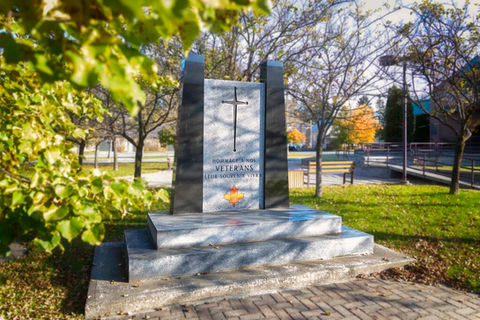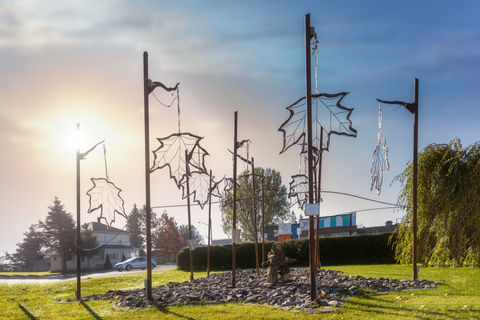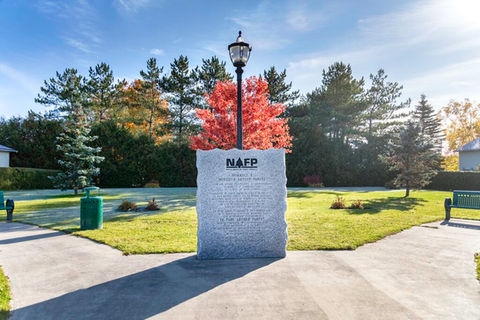
DISCOVER
SAINT-QUENTIN!
Historical
Saint-Quentin was carved out of a virgin forest in northern New Brunswick in 1910. Its establishment is closely linked to the development of the railway to connect the two hemispheres (east and west) of the province. The place was initially called "Five Fingers", the place where the first railway siding was built, near the river of the same name. This name was later changed to "Anderson Siding" in honour of the railway manager who had the station built on the site that was to become the centre of the community. In 1919, the name "Saint-Quentin" was adopted to celebrate the return of peace, in memory of a decisive victory by Canadian troops over the Germans during the Battle of the Somme during the First World War, at Saint-Quentin in France.
The territory was inaccessible, although its neighbouring regions had been settled and developed for over 150 years. There was considerable pressure to build a railway to provide access to this vast territory. The New Brunswick provincial authorities finally approved the initiative in 1897. The International Railway of New Brunswick (INR) took charge of the project in 1906. The latter completed the construction of a railway line in September 1910.
During this period, the priest of Balmoral, who would become the first archbishop of Moncton, Bishop Joseph Arthur Melanson, a colonizer at heart, made many efforts to obtain permission to found new parishes along this railway line. At the time, the French-speaking clergy advocated a return to the land, praising the cultivation of the soil, to counter the exile of Quebec families to English-speaking regions. Father Melanson's colonization work bore fruit and settlers flocked in the summer of 1910. The first resident of the territory was a railway worker named Simon Gallant, an Acadian from Prince Edward Island, who decided to settle his family near a stream where he had found his cow. However, the title of first settler was given to Élisée Labrie who was the first to begin clearing the land with his family. The community quickly prospered despite encountering numerous government obstacles, conflicts with forestry companies and devastating fires. In 1914, a census counted the presence of 254 settler families. The settlers were almost all French-speaking from Quebec, New Brunswick and the United States. Although the government initially did not believe in the possibility of establishing a town there, a few years later it cited Saint-Quentin as an example of successful settlement.
Saint-Quentin quickly acquired the infrastructure necessary for its development: church, schools, hospital, shops, public services, recreation and community spaces. The first chapel of the parish was built in 1911, the post office in 1912, the first school in 1913, the church in 1918 and the Hôtel-Dieu-St-Joseph hospital in 1947. The region developed under an agroforestry vocation. Beautiful fertile lands, flour mills, butter factories, forestry operations, sawmills and innovative factories emerged. Saint-Quentin took on the appearance of a small, independent town whose population enjoyed an enviable quality of life. The municipality is at the centre of a vast plateau located at an altitude of 1,000 feet in the Appalachian Mountains, which is full of rivers and natural environments including Mount Carleton Provincial Park (a protected area including the highest peak in the Maritimes). Saint-Quentin, located approximately 100 kilometres from its neighbouring towns, is considered by many to be "an island in a forest", a popular stopover. Its reputation as a resort is well established.
Saint-Quentin was incorporated as a Local Service District in 1947, as a Village in 1966 and was proclaimed a City in 1992. It was recognized as the "Maple Capital of the Atlantic" in 2004, reflecting the contribution of the maple industry to the sector, as well as the local flagship, Groupe Savoie, a local forest products processing company. Considered a dynamic and growing city, Saint-Quentin now has nearly 4,000 citizens. Its 99% French-speaking population enjoys a peaceful lifestyle connected to nature and wide open spaces.
Historical monuments
Most communities around the world have their historical monuments. They all have a sculpture or architectural work that serves to recall a fact that marked history or a person who accomplished a work, an action out of the ordinary. These steles have a historical and cultural value that testifies to the existence and reality of past events, but whose imprint must remain. They are also works created and built with the specific aim of keeping the memory of such an action or such a destiny always present and alive in the consciousness of future generations. The monument also mobilizes the memory of affectivity in such a way as to recall the past by making it vibrate in the manner of the present.
Saint-Quentin has a short history, but it has already been nearly 110 years since its founding in 1910. During all these years of evolution, development and change, the community has seen the erection of cenotaphs, steles, monuments in memory of notable people and events. Here is the list counted and approved by the Municipal Council.
Research and texts
Suzanne Coulombe, General Manager and Clerk
Linda Levesque Borris, Deputy Clerk
Town of Saint-Quentin
Sites and attractions
Centre touristique de l'ancienne gare

144A Canada Street
Saint-Quentin, NB, E8A 1G7
Phone: 506-235-3282 / Toll free : 1-888-666-2425
Operation of the Tourist Center: May to September
This replica of the Old Saint-Quentin Station built in 1920 houses a visitor information center, an exhibition room and the Service NB offices.
Stops through time

Phone : 1-506-235-3282 / Toll free number :1-888-666-2425
Open : may to october
Explore the heritage of Saint-Quentin in a route bringing together 17 heritage sites of the Town of Saint-Quentin in which you can visit on foot, by car or by bicycle. A leaflet explaining the route to follow is available at the Centre touristique de l'ancienne gare. An audio version of the circuit is also available for download.
Roy Heritage House

212 Canada Street
Saint-Quentin, NB, E8A 1H2
Phone: 506-235-3015
Operation: summer season
The Roy Heritage House was built in 1924. In this historical gem, you can find a reproduction of a period general store.
Giant Maple Leaf

Inaugurated on the occasion of the Centennial Celebrations, the structure of the giant maple leaf symbolizes the omnipresence of the maple industry in the region. The original project began in 2003, the year the Atlantic Maple Capital committee was founded, which, with its exceptional support, made it possible to raise the necessary funds ($150,000). Proudly placed at the southern entrance to the Town in Centennial Park since 2010 with its 25 feet height, the entirely copper structure is the work of the internationally renowned ironworker, Mr. Guy Bel de la Forge- Pique-Assault on Île d'Orléans, Quebec. Copper was chosen as a material because of its green tint, which it naturally acquires with age and which is similar to the leaf.
Community parks
Playgrounds

Castonguay Park
265 Guimond Street

Chouinard Park
8 Monique Street

Jean Park
161 Guimond Street

Querry Park
312 Martel Street
Public parks

Arthur Parent Park
242 Canada Street

Town Hall Park
206 Canada Street

Hector Savoie Park
146 Canada Street

Centennial Park
30 Canada Street

Intersection Park
230 Canada Street
Treaty of Friendship


In November 1998 a delegation from the Town Council went to Saint-Quentin, France, to sign the Treaty of Friendship between Saint-Quentin, France, and Saint-Quentin, Canada, on November 11, 1998, on the occasion of the 80th anniversary of the end of the First World War.
Twenty years later, in November 2018, a delegation from the Saint-Quentin, NB, Municipal Council returned to Saint-Quentin, France, on the occasion of the 100th anniversary of the Great War, from November 6 to 12, 2018: Visit to the French and German cemeteries and ceremony on the site of the stele inaugurated in 2000 in memory of the soldiers of Saint-Quentin who died in combat in France. During this stay, the Treaty of Friendship, in commemoration of the 20th anniversary of its signing between the two namesake cities, was solemnly renewed on November 10, 2018 by an official act of the bonds of friendship that unite them.
Creek Watershed
Five Fingers
2012 – MUNICIPAL INNOVATION PRIZE
The City of Saint-Quentin won the 2012 Municipal Innovation Award, awarded by the Association francophone des municipalités du Nouveau-Brunswick and sponsored by Roy Consultants for its project Community and sustainable improvement of the Five Fingers Creek watershed.
2014 – AWARD FOR EXCELLENCE IN WATER MANAGEMENT
The Five Fingers Creek Watershed Advisory Committee has been awarded the Council of the Federation Water Management Excellence Award for the province of New Brunswick. This is a national award.














